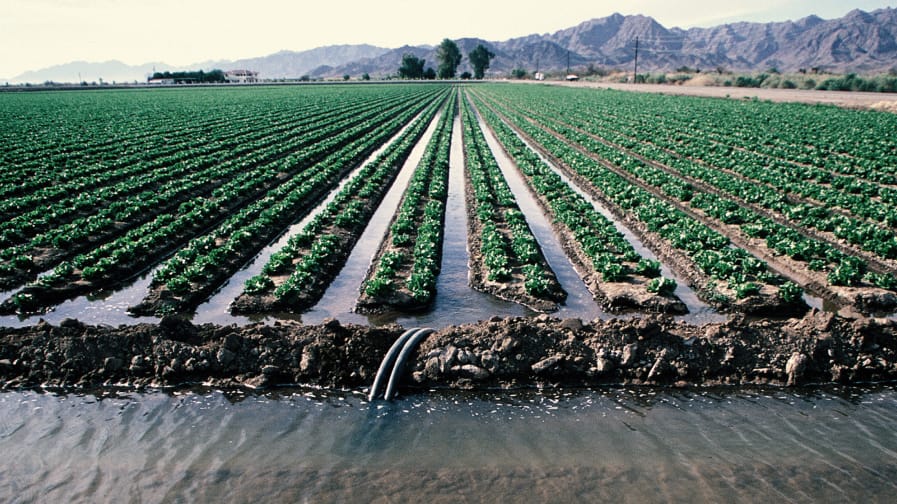What You’ll Learn From This Report
Key Findings
The American West is facing a water crisis, compounded by climate change, a history of bad policy, and government refusal to address Big Ag head-on. Huge agribusinesses remain unfazed by this crisis, continuing to abuse water supplies to feed animals on factory farms that, in turn, worsen the climate crisis and associated drought. Despite a short-term respite in late 2022 and early 2023 from a wet winter, a long-term megadrought persists across the region, as groundwater storage is being depleted after decades of over-withdrawals.1National Integrated Drought Information System, National Oceanic and Atmospheric Administration. “Special Edition Drought Status Update for the Western United States.” January 24, 2023; Griffin, Melissa et al. “Drought monitor spells good news for California, but ‘not out of the woods’ on megadrought.” ABC News. March 2, 2023. The Colorado River Basin is ground zero for Big Ag’s assault on our water and climate future, and states must begin standing up to these perpetrators to ensure a safe and livable future.
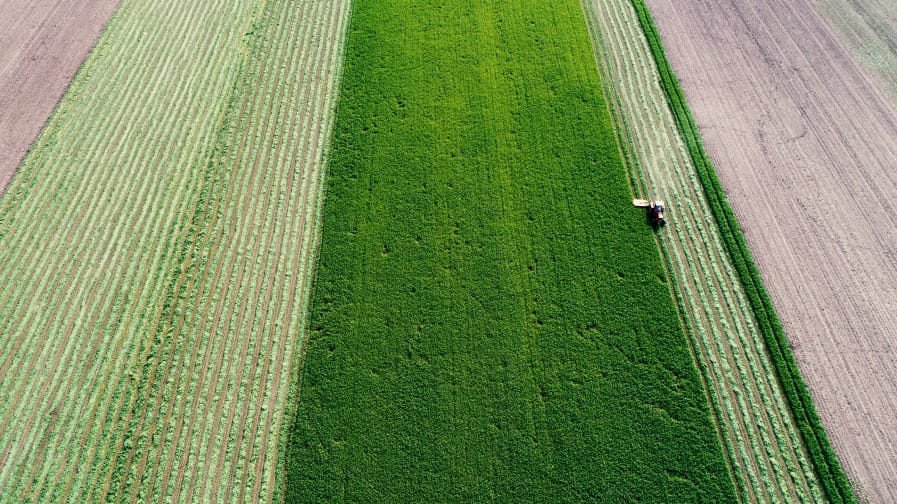
Findings
Alfalfa farming is a major culprit
- In 2022, alfalfa covered 2.7 million acres across the Colorado River Basin states, consuming more than 2 trillion gallons of irrigation water.
- Large-scale alfalfa farms (with 1,000 or more acres) make up less than 2 percent of all alfalfa farms in the Basin states. Around 94 percent used irrigation in 2017, together guzzling one-third of all irrigation water applied to alfalfa across the Basin states.
Mega-dairies are hugely culpable
- The Basin states are also home to 2.5 million cows living on mega-dairies, requiring an estimated 218 million gallons every day just to wash and hydrate them.
The Big Ag feedback loop
- Together, the Basin states exceed the national average for irrigation water applied per irrigated acre of farmland by more than 70 percent, with Arizona using over three times the national average.
- Colorado River Basin states are hijacked by Big Ag in a relentless feedback loop, requiring more and more water as climate change intensifies, thereby decreasing the amount of water available for all uses.
Crisis on the Colorado River
The Colorado River is one of the most regulated rivers in the world, due largely to its famous interstate water agreement, the Colorado River Compact.2Robison, Jason et al. “Challenge and response in the Colorado River Basin.” Water Policy. Vol. 16, Iss. 12. March 2014 at 12 to 13. Established in 1922, the Compact theoretically distributes 16 million acre-feet of water annually to seven states and Mexico. The Upper Basin states of Colorado, New Mexico, Utah, and Wyoming are obligated to deliver 7.5 million acre-feet to the Lower Basin states of Arizona, California, and Nevada, and the Upper Basin can only take its share from what remains.3Ibid. at 16 to 17.
This agreement has important ramifications across the West, with roughly one in ten Americans relying on the Colorado River Basin for their household water supply.4U.S. Bureau of Reclamation. Department of the Interior (DOI). “Colorado River Basin Ten Tribes Partnership Tribal Water Study.” December 2018 at i; Partlow, Joshua. “Officials fear ‘complete doomsday scenario’ for drought-stricken Colorado River.” Washington Post. December 1, 2022. Around 16 percent of the Basin’s area is on tribal land, with the river supplying water to dozens of American Indian tribes.5Robison et al. (2014) at 20; Bureau of Reclamation (2018) at i. By 2060, the Colorado Basin is projected to supply water to as many as 77 million people within the U.S., nearly double current figures.6Robison et al. (2014) at 17 and 20.
The Colorado River also supplies the nation’s two largest reservoirs, Lake Mead and Lake Powell, created by the Hoover and Glen Canyon dams, respectively. Lake Mead was originally designed to hold water for the Lower Basin states, while Lake Powell was created later to store water in case the Upper Basin could not deliver its promised amount.7Falconer, Rebecca. “Drought-hit Colorado River water supplies near ‘moment of reckoning.’” Axios. June 15, 2022; Bolinger, Becky. “Depleted by drought, Lakes Powell and Mead were doomed from the beginning.” Washington Post. September 10, 2021. These reservoirs also generate significant amounts of electricity — nearly 10 billion kilowatt hours per year combined.8Stern, Charles V. et al. Congressional Research Service (CRS). “Management of the Colorado River: Water Allocations, Drought, and the Federal Role.” R45546. May 5, 2023 at 9.
The Colorado River is the U.S.’s most endangered river.9Falconer (2022). Since the early 2000s, average annual water demand has exceeded supply, and the U.S. Bureau of Reclamation projects that annual demand will reach as high as 6.7 trillion gallons by 2050.10Robison et al. (2014) at 24; Fleck, John and Anne Castle. “Green light for adaptive policies on the Colorado River.” Water. Vol. 14, Iss. 2. 2022 at 2; Stern (2023) at 17. As demand increases, flows are trending in the opposite direction, with the annual flow down 20 percent since 2000.11Fleck and Castle (2022) at 2. Climate change is only worsening this trend — for every 1 degree Celsius of warming, the river’s flow declines by 9 percent.12Milly, P.C.D. and K.A. Dunne. “Colorado River flow dwindles as warming-driven loss of reflective snow energizes evaporation.” Science. Vol. 367, Iss. 6483. February 20, 2020 at abstract; James, Ian. The Republic. “About 40 million people get water from the Colorado River. Studies show it’s drying up.” USA Today. February 22, 2020.
Lake Powell and Lake Mead are in similarly dire situations. Lake Powell currently holds a quarter of its capacity, with water levels at 3,561 feet as of May 2023. It is only able to generate power above 3,490 feet, and dead pool — where water goes stagnant and cannot flow through the dam — is fewer than 200 feet away (see Fig. 1). This situation could be reached as soon as 2025.13Fountain, Henry. “Colorado River reservoirs are so low, government will delay releases.” New York Times. May 3, 2022; Yachnin, Jennifer. “Could a river finally run through the Glen Canyon Dam?” E&E News. January 27, 2023; U.S. Bureau of Reclamation. DOI. Water Operations: Historic Data. Available at https://www.usbr.gov/rsvrWater/HistoricalApp.html. Accessed June 2023. Record rainfall in early 2023 buoyed the lake’s levels, but this temporary reprieve provides only a year’s worth of breathing room.14Dance, Scott. “Lake Powell is rising more than a foot a day. But megadrought’s effects will still be felt.” Washington Post. May 11, 2023.
Bad policy leads to insufficient negotiations
The Colorado River Compact formed in 1922 during a period of abnormally wet rainfall, resulting in an agreement that allocated 15 million acre-feet annually among the states. Yet in recent decades, only 12 to 13 million acre-feet has flowed through the river each year.15Robison et al. (2014) at 23; Gardner, Jeff. “Deception and science in the Colorado River.” Desert Times. January 1, 2020; Fleck and Castle (2022) at 2. The Compact relies on fixed numbers, leaving little room for declining supplies and potentially leaving Upper Basin states unable to fulfill their obligations to the Lower Basin.16Sakas, Michael Elizabeth. “If the Colorado River keeps drying up, a century-old agreement to share the water could be threatened. No one is sure what happens next.” Colorado Public Radio. November 19, 2021. This dire scenario has not yet been reached, but the writing is on the dam walls. When Lake Mead and Lake Powell reached record lows in 2021, the Bureau of Reclamation issued a shortage declaration and began temporarily curbing water supplies to Upper Basin states.17U.S. Bureau of Reclamation. Letter to Paul Davidson. Chief, Water Management Group Water and Power Division. “Operation Plan for Colorado River Reservoirs.” August 21, 2021 at 1 to 2. It cut Arizona and Nevada’s supplies by 18 and 7 percent, respectively.18Sabo, John. “Are markets a wet dream for US Western water?” Forbes. February 10, 2022. Due to Western water law principles of seniority, California was spared.19Ronayne, Kathleen and Suman Naishadham. “California releases its own plan for Colorado River cuts.” Associated Press. January 31, 2023.
In June 2022, the federal government stepped in with an ultimatum for Compact states: create a plan to cut water over the next year, or the government will do it by force.20Sakas, Michael Elizabeth. “Colorado River states need to drastically cut down their water usage ASAP, or the federal government will step in.” Colorado Public Radio. June 17, 2022. The three Lower Basin states came to a proposed deal in May 2023, promising voluntary cuts of 3 million acre-feet by 2026. This amounts to 13 percent of the Colorado River water used each year in the Lower Colorado Basin, among the largest cuts ever taken. Reductions come with a call for the federal government to pay out $1.2 billion to the irrigation districts, cities, and American Indian tribes for their temporary water reduction.21Flavelle, Christopher. “A breakthrough deal to keep the Colorado River from going dry, for now.” New York Times. Updated May 25, 2023.
Even so, this proposed agreement only lasts until the end of 2026. Farmers may be incentivized to temporarily leave their land fallow, but this is not a permanent solution. The proposal also does not cut nearly enough water to restore the Colorado River — states need to cut four times as much annually for the reservoirs to recover.22Jones, Benji. “Why the new Colorado River agreement is a big deal — even if you don’t live out West.” Vox. May 23, 2023.
Alfalfa and Mega-Dairies Monopolize the Colorado River
Disputes between Basin states obscure the true problem underlying the Colorado River’s water crisis: an agricultural system that is wholly unsuited to the arid climate. Crop irrigation makes up 79 percent of all water consumed23“Consumed” means water diverted for irrigation that is removed from the immediate environment through evaporation, transpiration, or incorporation by crops. It is less than the total water “withdrawn” and applied to cropland, a portion of which returns to ground- or surface-water sources and is therefore available for future use. See U.S. Department of the Interior. U.S. Geological Survey. “Estimated Use of Water in the United States in 2015.” Circular 1441. 2018 at Glossary and 59 to 61. in the Colorado River Basin, and a staggering 70 percent of this water is used to irrigate livestock feed crops including alfalfa, other hays, and corn silage.24Richter, Brian et al. “Water scarcity and fish imperilment driven by beef production.” Nature Sustainability. Vol. 3. April 2020 at 320 and 321, Table 1. Alfalfa farms, along with the proliferation of mega-dairies, are sucking the Colorado dry — and the West’s lifeblood alongside it. Basin states must take firm and immediate action to rein in these water abuses.
Food & Water Watch estimates that alfalfa consumed 2.2 trillion gallons of water across the seven Basin states in 2022 alone (see Methodology). To put this in perspective, this is enough to meet the indoor household water needs of the nearly 40 million people who rely on the Colorado River system for municipal water25U.S. Bureau of Reclamation. DOI. “Colorado River Basin Water Supply and Demand Study.” December 2012 at 3. for three-and-a-half years (See Fig. 2). It is also enough to cover the area of two Connecticuts in a foot of water. Large-scale alfalfa farms (with 1,000 or more acres) guzzle around one-third of this water, despite making up less than 2 percent of all alfalfa farms in Basin states. In addition, the 2.5 million dairy cows living on mega-dairies26The U.S. Environmental Protection Agency’s definition of a medium dairy concentrated animal feeding operation (CAFO) includes those that confine 200-699 cows for at least 45 days per year, on operations that lack cropland or pasture and discharge waste into surface waters (see 40 CFR § 122.23). In this piece, mega-dairies refer to operations with 500 or more cows, as this corresponds with data categories in the 2017 U.S. Department of Agriculture Census of Agriculture, which do not provide information on confinement and waste management. in these states sucked up an estimated 218 million gallons every day just for washing and hydration.
The estimated 2.2 trillion gallons of water consumed by alfalfa across the seven Basin states in 2022 is enough to meet the indoor household water needs of the nearly 40 million people who rely on the Colorado River system for municipal water for three-and-a-half years.
Not all of this water comes from the Colorado River; even so, livestock feed crops remain the largest consumers of water in the Colorado River Basin, accounting for 55 percent of the water used.27Richter et al. (2020) at 320. Basin states together exceed the national average for irrigation water used per acre on all irrigated farmland by 71 percent (see Fig. 3).28U.S. Department of Agriculture (USDA). National Agricultural Statistics Service (NASS). “2018 Irrigation and Water Management Survey.” Volume 3, Special Studies, Part 1. AC-17-SS-1. November 2019 at 14.
The reasons why mega-dairies and thirsty crops such as alfalfa persist in regions prone to mega-droughts lies in decades of poor governance by states, along with federal agricultural policies that favor Big Meat and Dairy.
The Factory Farm Feedback Loop
Nearly every sector of the U.S. food system has undergone rapid corporate consolidation in recent decades, but few as severely as the dairy industry.29MacDonald, James M. et al. USDA. Economic Research Service (ERS). “Consolidation in U.S. Dairy Farming.” Economic Research Report No. 274. July 2020 at 11; Liebrand, Carolyn. USDA. Rural Business-Cooperative Service. “Structural Change in the Dairy Cooperative Sector, 1992-2000.” RBS Research Report 187. October 2001 at iii, 1, 3, and 11. Today, just three cooperatives market more than 80 percent of all fluid milk in the country30Lee, Seth. IBISWorld. “Dairy Farms in the US.” Industry Report 11212. July 2022 at 4, 7, and 17., leaving farmers with fewer buyers, who have greater leverage to set prices and determine milk routes. At the same time, federal dairy policy has shifted from price supports to a corporate-friendly export agenda. These forces have gutted farm income and increased pressure for farmers to “get big or get out” — to increase their herds to mega-dairy sizes or leave dairy farming altogether.31See Food & Water Watch (FWW). “The Economic Cost of Food Monopolies: The Dirty Dairy Racket.” January 2023.
Most of this growth in mega-dairies occurred in Western states, aided by milder climate and affordable land.32Blayney, Don and Mary Anne Normile. USDA. ERS. “Economic Effects of U.S. Dairy Policy and Alternative Approaches to Milk Pricing: Report to Congress.” Administration Publication No. 076. July 2004 at 3 to 5, 13, and 27 to 29; Hanawa Peterson, Hikaru. Kansas State University. “Geographic Changes in U.S. Dairy Production.” Presented at the Annual Meeting of the American Agricultural Economics Association. Long Beach, California. July 28-31, 2002 at 1 to 4; MacDonald et al. (2020) at 1, 5 to 7, and 18. Factory farms mushroomed, while family-scale dairies (those with fewer than 500 cows) collapsed, with states like California seeing a 60 percent loss over 20 years (1997 to 2017).33FWW analysis of USDA. NASS. 2017 Census of Agriculture. Available at https://www.nass.usda.gov/Publications/AgCensus/2017/index.php. Accessed May 2021. Alfalfa production feeds these mega-dairies, with the dairy industry being the primary user of forage crops like alfalfa.34Matthews, William A. et al. “The role of California and Western US dairy and forage crop industries in Asian dairy markets.” International Food and Agribusiness Management Review. Special Issue. Vol. 19, Iss. B. 2016 at 156; Putnam, Dan et al. “The importance of Western alfalfa production.” 29th National Alfalfa Symposium Proceedings. December 1998 at 6. The crop can be harvested multiple times a year in mild climates and grown in varying soil conditions — assuming that sufficient water is available.35Putnam et al. (1998) at 3 and 5. Today, the West grows nearly all of the country’s irrigated cattle feed supplies, despite alfalfa being a notoriously thirsty crop.36Richter et al. (2020) at 322; Olson-Sawyer, Kai. “Dairy, drought and the drying of the American West.” Salon. October 29, 2022.
Alfalfa grown in Basin states is not just feeding the U.S.’s appetite for dairy; the region also exports dairy products, along with alfalfa and other forage crops that feed foreign factory farms. For example, in 2021 California accounted for nearly a third of U.S. dairy exports by value, and for more than a fifth of all hay exports.37California Department of Food and Agriculture. “California Agricultural Statistics Review, 2021-2022.” 2022 at 114. Foreign corporations are even capitalizing on this farming system that is out of touch with the climate reality. The Almarai Company, a Saudi multinational, owns 10,000 acres of Arizona farmland, cultivating alfalfa to support dairies in Saudi Arabia, which banned alfalfa cultivation in 2018 in order to conserve water.38[1] Nilsen, Ella. “Wells are running dry in drought-weary Arizona as foreign-owned farms guzzle water to feed cattle overseas.” Arizona’s Family. Updated December 29, 2022; Koch, Natalie. “Arizona is in a race to the bottom of its water wells, with Saudi Arabia’s help.” New York Times. December 26, 2022. This gross misuse of water has been unfolding for years, with 75 percent of Lake Mead’s decline in the past two decades attributed to cattle feed irrigation.39Richter, Brian et al. [Supplemental materials]. “Water scarcity and fish imperilment driven by beef production.” Nature Sustainability. Vol. 3. April 2020 at 5; Farah, Troy. “US rivers and lakes are shrinking for a surprising reason: Cows.” Guardian. July 2, 2020.
However, even prolonged drought conditions have not broken the West’s dependence on alfalfa. The 2011 to 2017 drought only modestly reduced California’s alfalfa production, with some regions actually increasing production. This includes regions in Southern California with “very secure senior water rights” that continued to receive their full allocations and thus had little incentive to reduce production (see Fig. 4).40Cantor, Alida A. et al. “Changes to California alfalfa production and perceptions during the 2011-2017 drought.” Geography Faculty Publications and Presentations. Vol. 238. 2022 at 20 to 22. This underlines the fact that state and federal water governance can play a stronger role than climate patterns in farmers’ planting decisions.41Ibid.; Matthews et al. (2016) at 152 and 155.
Basin states cannot break free from their dependence on alfalfa and dairy without changes to federal and state water governance, along with support for family-scale farmers to transition to more sustainable farming systems. Yet leaders remain reluctant to take these necessary steps — perpetuating a water crisis in Basin states.
Tribal Water Rights
The dozens of American Indian tribes in the Colorado River Basin hold the most seniority to its water, having lived on the land before any state or federal laws even existed. Federally recognized rights account for as much as 25 percent of the river’s flow.42Water & Tribes Initiative. [Issue brief]. “The Status of Tribal Water Rights in the Colorado River Basin.” April 2021 at 1; Fonseca, Felicia. “State of unease: Colorado basin tribes without water rights.” Associated Press. September 15, 2022. Despite this fact, the tribes have been historically neglected from water rights discussions. They were excluded during the creation of the Compact and ignored again in 2007 during renegotiations.43Sakas, Michael Elizabeth. “Historically excluded from Colorado River policy, tribes want a say in how the dwindling resource is used. Access to clean water is a start.” Colorado Public Radio. December 7, 2021. This has led to a patchwork of rights across the basin, where some tribes have officially quantified water rights while others are still working to achieve them. Many of these rights exist only on paper, with the tribes having no way to access the water due to legal conflicts, prior designated use, or lack of infrastructure.44Colorado River Research Group. “Tribes and Water in the Colorado River Basin.” University of Colorado Law School, Getches-Wilkinson Center for Natural Resources, Energy, and the Environment. June 2016 at 3; Swanson, Conrad. “What part do Native American tribes play in fixing the Colorado River shortage?” Denver Post. Updated January 4, 2023.
Paper rights are a slap in the face on top of historical injustices. The designations often fail to account for the historical context of land theft lurking behind every stolen water right, making the continued inequities even more unjust. Without infrastructure to access the water, Upper Basin tribal water flows downstream and is lost, depriving tribes of their resource without compensation.45Swanson (2023). In Utah, for example, the Ute tribe has seen its water rights debated and slashed down, while other priorities such as the Central Utah Project receive funding and water.46Fonseca (2022).
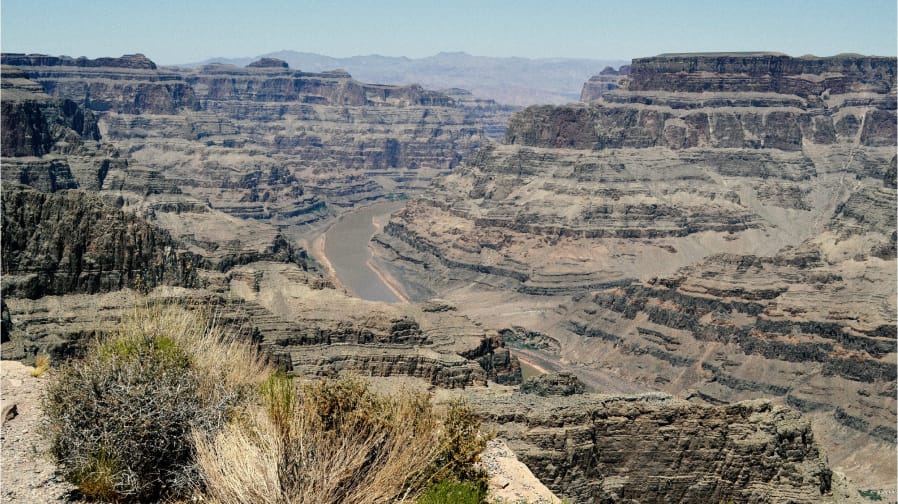
For those still battling out water rights, the situation can be even more enraging. For the Hualapai tribe in Arizona, the Colorado River borders more than 100 miles of their land, but they cannot draw a single drop from it. As the river’s water continues to shrink, their water rights are tied up in Congress, forcing them to postpone building fire stations and elementary schools. Often, tribes will be forced to cede huge water rights in order to receive assurance of supply and funding for delivery, pulling what they can from bad deals.47Ibid.
Many tribes have begun to lease out their water rights for energy production, endangered species recovery, or city use.48Ibid. Extra water could be sold to the federal or state governments as well, to support reservoir levels at Lake Mead or Lake Powell.49Swanson (2023). While this is a possibility for some, tribes should not have to cede their water before massive users like Big Ag do the same. Tribal waters are needed to supply clean drinking water and to sustain communities,50Ibid. a far superior use than much of the agricultural production across the West.
Consequences of Inaction
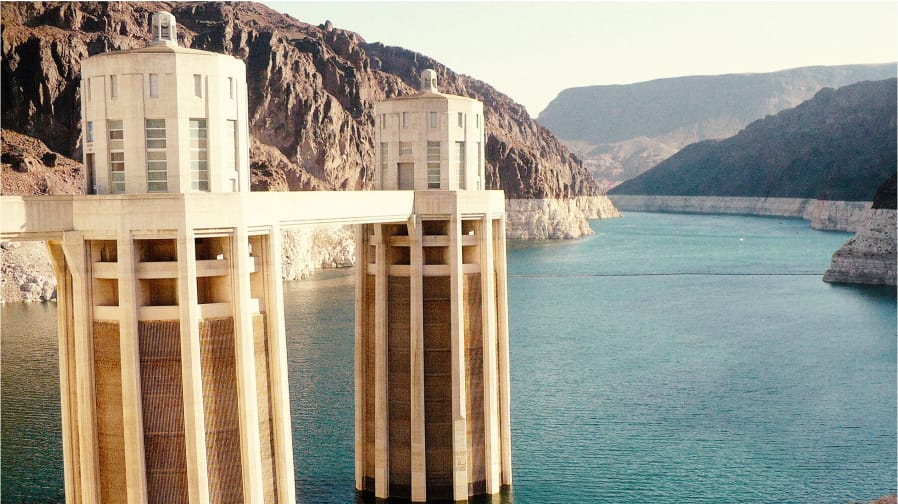
Loss of water and energy
If nothing is done to conserve water and to cut back on Colorado River usage, disaster will follow. Lake Powell and Lake Mead are some of the grimmest indicators, with each reservoir dangerously low. The first level of concern is the minimum power pool elevation — the lowest level at which water continues to power the respective dam’s hydropower. When the water level approaches this point, the turbines begin to take in both air and water, forcing them to be shut down to avoid permanent damage.51Glennon, Robert. “What is dead pool? A water expert explains.” The Conversation. Updated May 13, 2022.
Minimum Power Pool: The lowest level at which water continues to power the dam’s hydropower.
Should hydropower cut off at either dam, this will bring the greatest harm to American Indian tribes, rural cooperatives, and small towns. These groups would be forced to buy energy on the open market, potentially from fossil fuel sources and at hugely inflated prices. Glen Canyon Dam in Arizona, which supplies energy for 4.5 million people, sells electricity at $30 per megawatt hour, compared to prices as high as $1,000 per megawatt hour on the open market.52Ibid.; Partlow (2022). Glen Canyon Dam already generates 40 percent less power than what has been promised to customers.53Partlow (2022).
Should the minimum pool elevation be bypassed, the next crisis emerges 120 feet below it: dead pool, where water becomes stagnant. Smaller, rarely used pipes would take over the role of passing water along. This would immediately slash the dam’s water releases by two-thirds. If levels fall much further than that, no water at all would be able to pass through the dam to deliver water to Lower Basin states. Years ago, either of these scenarios would have been unthinkable. Now, they are all part of the planning process and could come within the decade.54[1] Ibid.; Jacobo, Julia. “Here’s what will happen if Colorado River system doesn’t recover from ‘historic drought.’” ABC News. April 19, 2023.

Crop failures
Draining the Colorado River puts many of the nation’s food crops in serious peril, including winter crops such as lettuce and broccoli.55Jones, Benji. “The Colorado River drought is coming for your winter veggies.” Vox. August 20, 2022. Although the climate may not be conducive to these crops,56Barker, Burdette et al. “Agricultural irrigated land and irrigation water use in Utah.” Utah State University, Irrigation Extension. Accessed May 2023; McNeece, Brian. “Wyoming: Unhappy in its own way at the top of the Colorado River.” Desert Review. Updated January 12, 2023; Nevada Department of Agriculture. “Agriculture in Nevada.” Available at https://agri.nv.gov/Administration/Administration/Agriculture_in_Nevada. a few key regions within the Colorado River basin supply numerous winter vegetable crops; Yuma, Arizona and the Imperial Valley in California together produce more than 90 percent of the nation’s winter leafy greens.57Jones (2022).
These crops are first in line to be cut, while water-intensive nut acreage typically remains safe. Nut trees are more valuable for farmers and require long-term investments, leaving them as favored crops to receive water in times of shortages.58Jones (2022). Strategic and targeted planting must be used now before it is too late, and alfalfa and mega-dairies need to be prevented from using so much water across the Colorado River Basin.
As climate change and drought intensify, grocery store prices rise in tandem. When Arizona or the Imperial Valley apply their water cuts to crops used for human consumption, supply shrinks dramatically. As this happens, food becomes more expensive.59Ibid. This is not a crisis unique to the Colorado Basin. Food security across the world is threatened by climate change as rising carbon dioxide levels decrease crop nutrition, extreme weather destroys crops, and drought reduces water availability.60City of Chicago, U.S. Environmental Protection Agency. “Climate impacts on agriculture and food supply.” Available at https://climatechange.chicago.gov/climate-impacts/climate-impacts-agriculture-and-food-supply. Accessed June 2023.
Ecosystems in peril
For years, the greatest dangers posed to Colorado River species were the myriad human-made dams and other water control devices that upend their habitats. Now, the entire Colorado River ecosystem has been transformed by human-induced drought conditions. As water levels decline, water temperatures have skyrocketed. In 2000, summer water temperatures in the Glen Canyon dam averaged 48.5 degrees Fahrenheit, but just two decades later, in 2022, they jumped to an average of 65.5 degrees Fahrenheit.61FWW analysis of U.S. Geological Survey (USGS). Grand Canyon Monitoring and Research Center. “Glen Canyon Dam near Page, AZ.” Available at https://www.gcmrc.gov/discharge_qw_sediment/station/GCDAMP/09379901#. Accessed July 2023.
This has radically shifted the aquatic ecosystem, allowing invasive species such as the smallmouth bass to thrive and endangering other native fish like the threatened humpback chub.62Partlow (2022); Jones, Benji. “These 8 species depend on the Colorado River. What happens as it dries up?” Vox. Updated April 21, 2023. Warming waters also lower dissolved oxygen levels, posing additional threats to species such as the rainbow trout and the cutthroat trout — which now barely survives in 10 percent of its historic range.63Ibid. As of now, no modern Colorado River species has gone extinct, but this could change.64[1] Lohan, Tara. “Left out to dry: Wildlife threatened by Colorado River Basin water crisis.” Revelator. September 12, 2022.
Extreme drought conditions also drive the collapse of desert bird populations. Typical bird species across the Mojave Desert have declined an average of 43 percent over the past century, with the decline in precipitation being one of the largest drivers.65Iknayan, Kelly J. and Steven R. Beissinger. “Collapse of a desert bird community over the past century driven by climate change.” Parks Stewardship Forum. January 6, 2020 at abstract. Burrowing owls are a particularly grim example, experiencing an astonishing 98 percent decline in their breeding population in just 16 years, along with reduced body mass.66Cruz-McDonnell, Kirsten and Blair O. Wolf. “Rapid warming and drought negatively impact population size and reproductive dynamics of an avian predator in the arid southwest.” Global Change Biology. Vol. 22, Iss. 1. September 14, 2015 at abstract.
With the Earth already facing a human-caused sixth mass extinction,67Cowie, Robert H. et al. “The Sixth Mass Extinction: Fact, fiction, or speculation?” Biological Reviews. Vol. 97. January 10, 2022 at abstract and 656 to 657. animal and plant ecosystems require as much assistance as they can get. Instead, humanity’s refusal to act in both their and our best interests for survival has put numerous additional species at risk. As the Colorado River continues to dry up, so do these species’ chances of surviving ongoing climate change.
SPECIES AT RISK
Endangered Wildlife of the Colorado River
With the Earth already facing a human-caused sixth mass extinction, animal and plant ecosystems require as much assistance as they can get. Instead, humanity’s refusal to act in both their and our best interests for survival has put numerous additional species at risk. As the Colorado River continues to dry up, so do these species’ chances of surviving ongoing climate change.
SCROLL SIDEWAYS TO NAVIGATE
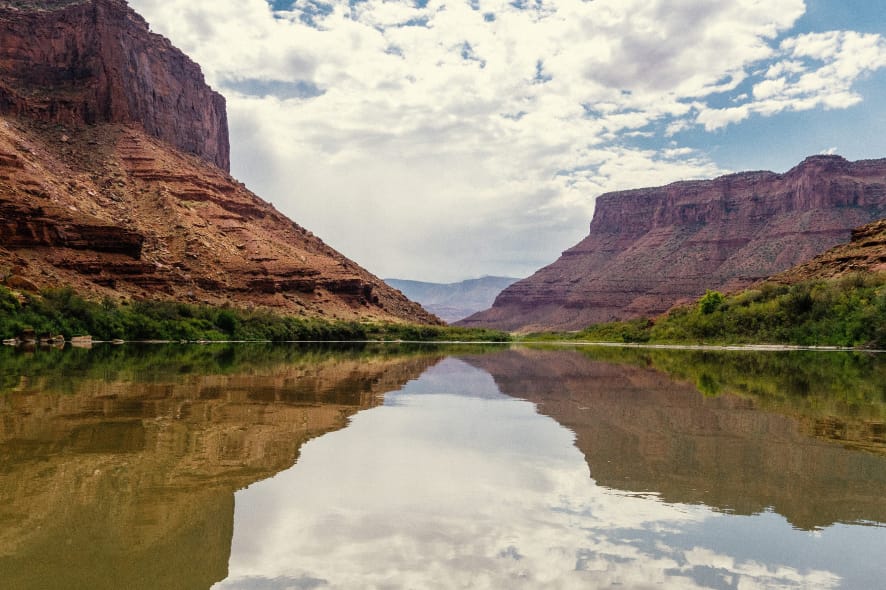
WESTERN BURROWING OWLS
Western Burrowing Owls are permanent residents of the Southwestern U.S., but their numbers are dwindling. The owls are labeled vulnerable or imperiled in nearly every state within their territory. Severe drought and climate change may already be driving this decline, with future projections for the area only growing hotter. As the Colorado River shrinks and water use is cut back, burrowing owls struggle to survive in a rapidly changing landscape. Ironically, efforts to conserve water are making less water available to the owls, who had adapted to the man-made farms and irrigation systems. Moving forward, the species needs more attention and protection as it adapts to climate change.

SAGUARO CACTUS
The iconic Saguaro Cacti are struggling to survive Arizona’s droughts, with many dropping arms or toppling over altogether. Though the species is not yet endangered, Saguaros are increasingly threatened by a seemingly benign source: cattle feed grass. Apart from guzzling up the Colorado River’s water, the introduction of these exotic grasses to the desert has created the perfect environment for fire to spread, a threat the Saguaro Cacti are unadapted to. Should their populations drop off, entire ecosystems will be threatened by the loss of this keystone species, and countless birds, insects, and bats will lose a vital food and shelter source.
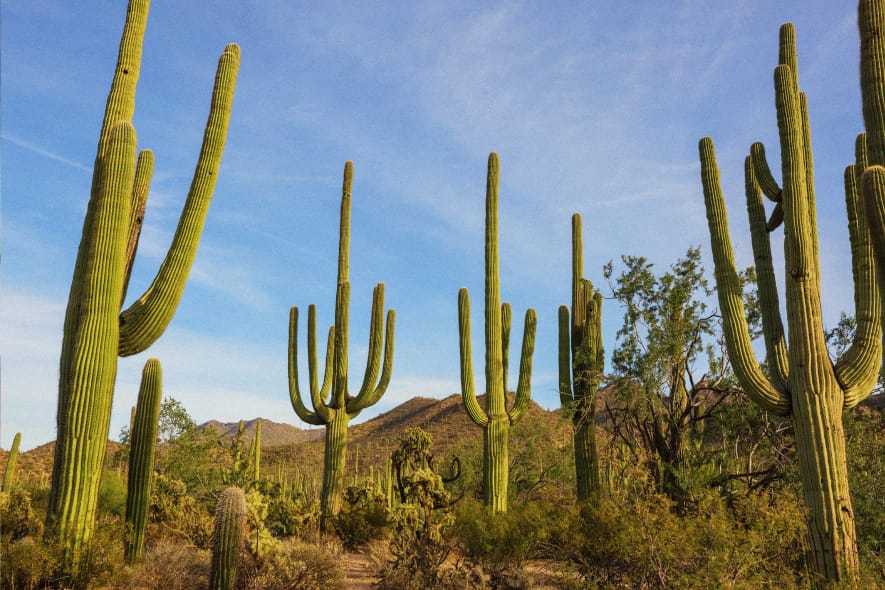
LESSER LONG-NOSED BAT
Lesser Long-Nosed Bats inhabit the Southwestern U.S. and Mexico, feeding off the nectar of flowering plants like agave and Saguaro Cacti. In fact, pollination by these little creatures supports tequila production across Mexico. But the bats, and the tequila byproducts alongside them, are facing serious threats from climate change and habitat loss. One study found that even under optimistic conditions, 59 percent of the bat’s habitat will be unsuitable for habitation by 2050. As temperatures rise and precipitation declines, the plants the bats depend on may shift their habitats or fail to flower. This includes Saguaro Cacti, which long-nosed bats depend on for night-blooming flowers.
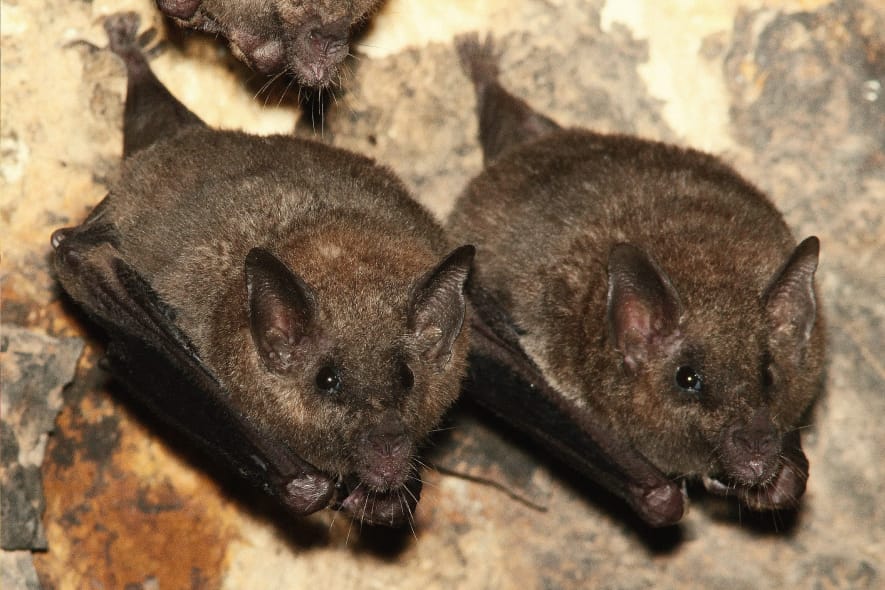
BONYTAIL CHUB
Bonytail Chub are the rarest of the Colorado River’s endemic fish, evolving 5 million years ago. Their populations remain critically low even as other species begin the road to recovery; so low in fact, that the species is ‘functionally extinct,’ or unable to self-sustain their populations in the wild. Bonytails once swam along the entire expanse of the Colorado River, but now, due to man-made disruptions and draining of the river, this has shrunk dramatically. But even these populations could not survive without hatcheries to raise and release the fish annually. The ever-present threat of environmental pollutants, like spills or leaching of chemicals, still poses serious risk to bonytails, as does alteration of habitat. Recovering the Colorado River is a matter of life or full extinction for these fish.
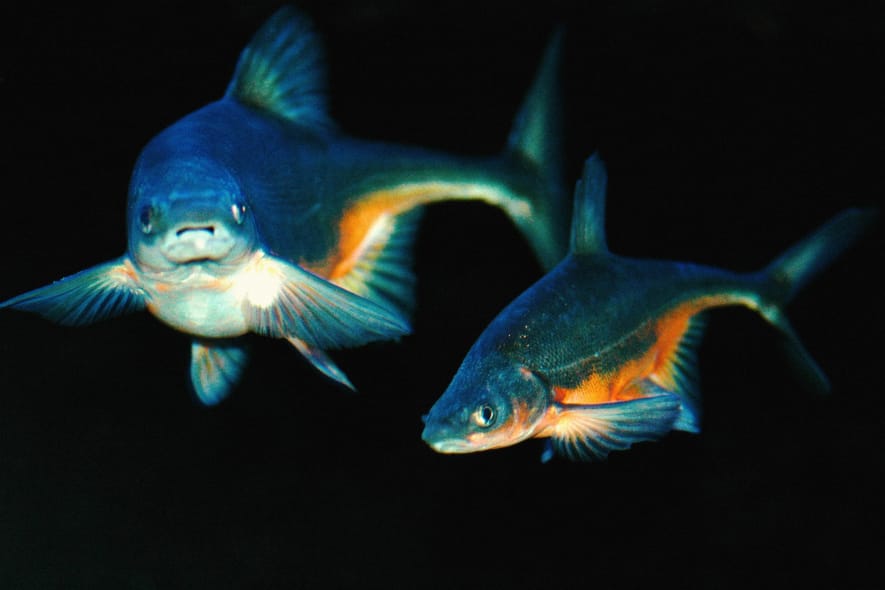
RAZORBACK SUCKER
Razorback Suckers are endemic only to the Colorado River, over 3 million years old, and known to some as the “dinosaurs of the Colorado.” Classified as endangered since the 1990s, their populations are in decline throughout the Colorado River, with the Lower Basin seeing populations plummet over the last two decades. Human diversions of the river disturbed their natural habitats and processes, and the species has never recovered. Even now, Razorbacks’ critical habitats and hatcheries along the main Colorado River tributary, the Green River, face contamination from oil and gas companies eager to drill despite the risk to the fish. Their populations are only just beginning to be seen in the wild, but their recovery is still dependent on hatchery support and a clean, flowing river.
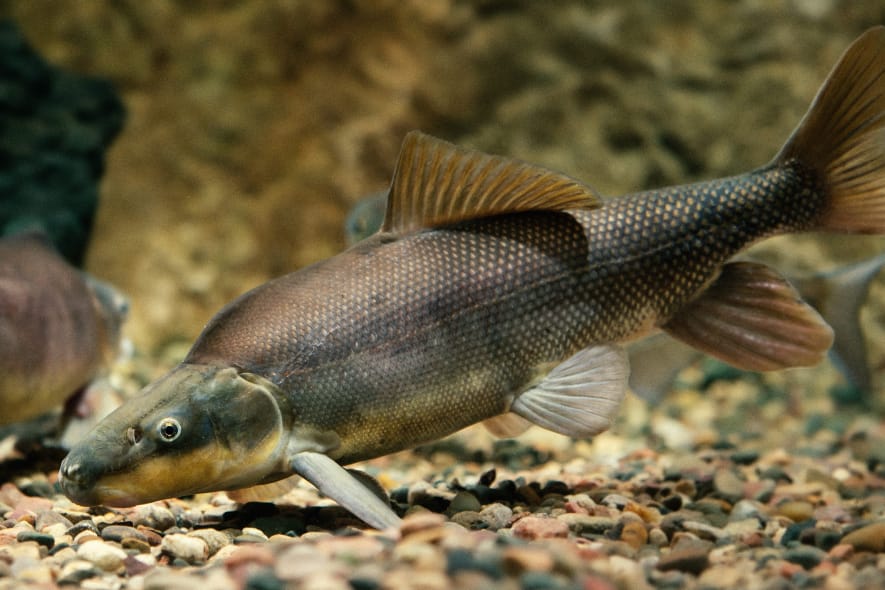
Conclusion and Recommendations
The Colorado River is deeply in crisis, and the solutions are already known. The arid U.S. West cannot sustain the factory farm system as water shortages continue. States must immediately de-prioritize wasteful industries such as large-scale alfalfa, nut trees, and mega-dairies. Each of these only contributes to worsening drought and climate change along the river, and continuing along this path only leads to harming communities and ecosystems that are struggling to survive in a hotter climate.
As Basin states and the U.S. Bureau of Reclamation consider how best to move forward with allocations beyond 2026, state leaders must take this opportunity to radically rethink how water is used going forward in their states. Without drastic changes, there will not be enough water to sustain our future.
Food & Water Watch recommends:
At the federal level
- Pass the Farm System Reform Act (FSRA), which would put a moratorium on new and expanding factory farms and help transition dairy farmers away from factory farms. Pass a Farm Bill that incorporates the FSRA.
- Restrict federal conservation dollars from being used to prop up factory farms and alfalfa acreage.
- Restrict exports of alfalfa.
At the state level
- Ban new mega-dairies and the expansion of existing ones.
- Stop new and expanding large-scale tree nut and alfalfa acreage.
- Help transition small and medium-sized growers to more geographically appropriate and resilient crops.
- Improve water management practices by defining all water as a public trust resource, not a commodity subject to resource extraction at the expense of the public.
Tell authorities to take these steps and protect the Colorado River!
Methodology
Crop calculations
We used an estimate of total water withdrawn and consumed by alfalfa in 17 Western states by Richter (2020),68Richter, Brian et al. “Water scarcity and fish imperilment driven by beef production.” Nature Sustainability. Vol. 3. April 2020 at 321 and 325. which relied on the U.S. Department of Agriculture’s (USDA) 2012 Cropland Data Layer and compared this to 2012 USDA Census of Agriculture data on total tonnage of irrigated alfalfa produced across the same states. (“Consumed” means water diverted for irrigation that is removed from the immediate environment through evaporation, transpiration, or incorporation by crops. It is less than the total water “withdrawn” and applied to cropland, a portion of which returns to ground or surface-water sources and is therefore available for future use.)69Dieter, C.A. et al. USGS. DOI. “Estimated Use of Water in the United States in 2015.” Circular 1441. 2018 at Glossary at 59 and 61.
This amounted to an average of 6.5 inches of consumptive water per ton of irrigated alfalfa produced (or 2.4 acre-feet per acre harvested), which is relatively in line with consumptive estimates in Basin states from various sources,70Hansford Economic Consulting. “Diamond Valley GID Financial Model Feasibility Analysis.” June 2013 at Appendix A at 4; Sloan, Jim. University of Nevada, Reno. “How much water does alfalfa need?” 2009; Chan, Nancy et al. SRI International. “The Utah Golf Economy: Economic and Environmental Impact Report.” January 2014 at 21; Berrade, Abdel F. and Denis Reich. “Alfalfa irrigation water management.” In Pearson, Calvin H. et al. (Eds). (2011). Intermountain Grass and Legume Forage Production Manual. Colorado State University Extension TB11-02 at 2. although likely below usage in regions of California that harvest alfalfa up to 10 times a year.71Johnson, Renée and Betsy A. Cody. CRS. “California Agricultural Production and Irrigated Water Use.” R44093. June 30, 2015 at 18; Geisseler, Daniel and William R. Horwath. University of California, Davis. “Alfalfa Production in California.” Updated June 2016 at 2. It is also lower than estimates in recent Food & Water Watch reports featuring California72FWW. “Big Ag, Big Oil, and the California Water Crisis.” February 2023. and New Mexico,73FWW. “Big Ag Fuels New Mexico’s Water Crisis.” July 2023. which instead used regional estimates of total irrigation water withdrawn and applied.
We applied the 6.5 inches figure to 2022 USDA Agricultural Survey data on alfalfa production in each Basin state. Since Survey data do not report alfalfa harvests by irrigation status, we estimated the percent of alfalfa acreage irrigated in each Basin state in 2017 (the latest Agricultural Census year) and adjusted the 2022 survey data to reflect these estimates. Similarly, we estimated water use by large alfalfa farms (harvesting 1,000-plus acres) using 2017 Census data.
Pecan water use estimates for New Mexico and Arizona come from Griego (2022),74Griego, Tylee M. University of New Mexico. “When high-water-use neighbors move in: Farming pecans in Valencia County, New Mexico.” May 2022 at 28 to 29. whose literature review found that the amount of water diverted for irrigating pecan trees in the U.S. Southwest ranged from 4.3 to 8.2 acre-feet per acre per year. We used the midpoint of 6.25 acre-feet per acre annually and applied it to USDA Survey data on pecan-bearing acres in both states. Almond and pistachio water use estimates for California come from a Congressional Research Service report75Johnson and Cody (2015) at 18. citing data from the University of California at Davis, which estimates 3.5 acre-feet per acre per year of applied irrigation water. We similarly applied this figure to USDA Survey data to estimate the increase in water diverted to expanding nut crop production in California.
Dairy calculations
The U.S. Environmental Protection Agency’s definition of a medium dairy concentrated animal feeding operation (CAFO) includes those that confine 200-699 cows for at least 45 days per year, on operations that lack cropland or pasture and discharge waste into surface waters.7640 CFR § 122.23. In the present report, mega-dairies refer to operations with 500 or more cows, as this corresponds with data categories in the 2017 USDA Census of Agriculture, which do not provide information on confinement and waste management.
We pulled USDA Agricultural Census and Survey data to estimate the total milk produced on operations with 500 or more head of dairy cows within each Basin state. We applied these figures to an equation from Mekonnen et al. (2012),77Mekonnen, Mesfin M. and Arjen Y. Hoekstra. University of Twente. “A global assessment of the water footprint of farm animals.” Ecosystems. Vol. 15. 2012 at 406 and 408. which estimated the total lifecycle water use needed to produce feed, water cows, and clean buildings at industrial-scale dairy operations in the U.S. (it does not include water used to flush manure into storage systems). Since this report also focuses heavily on water consumed by alfalfa (a major livestock feed), we focused on the water simply needed to water the cows and wash facilities, which Mekonnen et al. estimate at 1.9 percent of the total lifecycle use.
Water use comparisons
We used the State of California’s target of 42 gallons per person per day as our basis for residential indoor water needs.78CA S.B. 1157 § 679 (2022). We pulled population and land area data on Basin states and cities (not the greater metropolitan areas) as well as average persons per household, from the U.S. Census Bureau’s QuickFacts.
Endnotes



